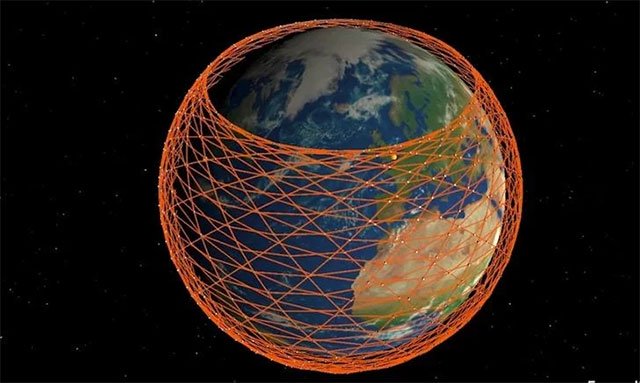Despite concerns from astronomers, SpaceX launched 60 additional Starlink internet satellites into space
SpaceX launched a series of 60 Starlink internet satellites into earth orbit on January 7, marking the return of the project to develop Starlink network in 2020.
Starlink is an initiative of the SpaceX aerospace group founder, billionaire Elon Musk, involved in establishing a global high-speed wireless Internet network with a combination of nearly 12,000 signaling satellites. from outer space (more than 6 times the number of spacecraft operating in outer space). The idea here is to provide stable coverage for rural or remote areas, rugged terrain, where the establishment of fiber optic lines will be extremely difficult and expensive. Also provides a more flexible internet connection service option for users no matter where they go.
According to the plan, SpaceX has launched a total of 60 test satellites into space 440 km from Earth with the early-stage Falcon 9 rocket, of which 57/60 are connected to ground control stations. At this next launch, SpaceX sent 60 more Starlink satellites into low-earth orbit. Not only that, Elon Musk also plans to launch a series of 60 Starlink satellites every 2-3 weeks during the next 12 months, a percentage expected to create enough coverage to provide the ice network. global broadband in the middle of this year.
These satellites will fly in a relatively low orbit above the atmosphere, and cover the internet below, providing service to all regions around the world.

However, this seemingly perfect idea of Elon Musk is faced with many opposing views. Besides concerns about the possibility of global economic imbalance. There is another concern about the debris of these satellites that can become nasty waste in space, increasing the risk of satellite collisions as well as affecting the Planned plan.
In addition, because each Starlink satellite is equipped with a special coating to protect the device from harmful radiation from the sun, this large-scale reflection of light can completely affect the ability to deep-space observation capabilities of space scientists, as well as images taken by telescopes. More seriously, this global satellite network is supposed to interfere with the radio wavelengths used in space-related work by global aerospace agencies.
Gwynne Shotwell, SpaceX president and CEO, said recently that the company is actively working with astronomers to find a solution to the problem, promising to conduct tests. necessary and find the best way to neutralize the interests of all parties.
You should read it
- Elon Musk's Starlink network is capable of imbalancing the global network economy
- Elon Musk posted a Twitter post, showing off the Internet provided by the Starlink satellite system was working
- What is Starlink? How does satellite internet work?
- Starlink satellite internet expands globally with new package priced at $200/month
- Elon Musk's satellite Internet device was hacked with a homemade device for $ 25
- If you want to know how 'terrible' Elon Musk is, look at SpaceX employees: 1 am in a company emergency meeting just to answer the boss's question 'Why don't you work 24/7'
 LE Audio, the new Bluetooth standard that helps listen on multiple devices at the same time, reduces latency when listening to music
LE Audio, the new Bluetooth standard that helps listen on multiple devices at the same time, reduces latency when listening to music CES 2020: Intel unveils Tiger Lake CPU, promising 'badass' graphics processing performance
CES 2020: Intel unveils Tiger Lake CPU, promising 'badass' graphics processing performance Google Chrome will stop supporting Windows 7 after 18 months
Google Chrome will stop supporting Windows 7 after 18 months![[CES 2020] MSI announced two high-end Creator 17 and Prestige 14 laptops at the same time](https://tipsmake.com/data/thumbs_80x80/[ces-2020]-msi-announced-two-highend-creator-17-and-prestige-14-laptops-at-the-same-time_thumbs_80x80_IY02ETejh.jpg) [CES 2020] MSI announced two high-end Creator 17 and Prestige 14 laptops at the same time
[CES 2020] MSI announced two high-end Creator 17 and Prestige 14 laptops at the same time The Y2K problem is coming back, after more than 20 years
The Y2K problem is coming back, after more than 20 years Users are not yet ready to give up Windows 7
Users are not yet ready to give up Windows 7